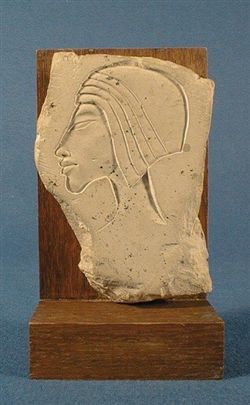
Aunque son muchos los Museos de todo el mundo que conservan objetos egipcios, desconocemos casi siempre a los artistas o artesanos que los realizaron. Solamente raras veces tenemos referencia de la persona concreta que hizo el objeto. A pesar de ello, sabemos cómo se desarrollaba su trabajo, que fue representado en las paredes de algunas tumbas ilustrando, en ocasiones, todo el proceso. Además, los propios objetos nos revelan cómo se hicieron. Muchas de las herramientas que utilizaron proceden de excavaciones, y también podemos verlas representadas en las paredes de las tumbas. Las escenas nos muestran la manufactura de objetos metálicos, así como la fundición del metal; vemos los fuelles o las pipas de soplar avivando el fuego. El metal fundido aparece depositado en el interior de los moldes realizados tanto en piedra como en cerámica y en ocasiones también se documenta el proceso de fusión de un metal con otro. La técnica de la "cera perdida" fue muy utilizada en el Antiguo Egipto. Primero se hacía el objeto en cera y se cubría con una capa de arcilla; cuando ésta se cocía, la cera se fundía y el molde quedaba hueco, introduciéndose entonces en su interior el metal fundido. Con esta técnica se hacían estatuas, herramientas y armas. Además, el metal y fundamentalmente el oro, era martilleado hasta que se conseguía una fina lámina. Las representaciones nos muestran la precisión con las que se pesaba el metal o el metal precioso, lo que resulta extremadamente interesante para conocer los distintos tipos de balanzas que suelen aparecer con Maat, la diosa de la verdad. La cantidad de metal era registrada minuciosamente. Los objetos de madera eran realizados tanto con madera local como con madera importada. Tenemos herramientas que fueron utilizadas por los carpinteros: hachas, cinceles, taladros, etc., pertenecientes a todos los periodos, incluso el Predinástico. Las técnicas empleadas por los carpinteros se aplicaban también a otros materiales, como el hueso y el marfil. Existieron centros para la manufactura del vidrio y de la fayenza y sabemos cómo se realizaban los tejidos: la hebra era hilada para convertirla en tejido de lana o lino con el que posteriormente realizaban los vestidos. Las cuerdas, las esteras y las cestas eran realizadas con fibras o juncos; también se trabajaba la piel. La cerámica se realizó desde tiempos predinásticos. Muchas vasijas fueron también fabricadas en piedra; primero se tallaba el bloque y luego se procedía a cortar, taladrar y alisar hasta que el objeto estuviese terminado. De manera similar se hacían las estatuas en piedra. El artesano trabajaba en talleres al servicio del rey, el Estado o el templo, aunque también podía hacerlo para ciudadanos particulares. Los trabajadores de la ciudad de Deir el-Medina eran los responsables de la construcción de las tumbas reales y de los ajuares que se depositaban en ellas. Sabemos que trabajaban en dos cuadrillas, la izquierda y la derecha, y quizá cada una de ellas hacía una parte de la tumba. Cada cuadrilla tenía su propio supervisor que vigilaba el trabajo de los que tallaban la piedra, de los escultores, yeseros, delineantes y artesanos. Los escribas anotaban las ausencias y los motivos de las mismas, supervisaban la distribución de las herramientas (las de bronce eran muy caras) y pagaban los salarios. El dios Ptah fue el patrón de los artesanos.